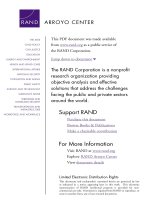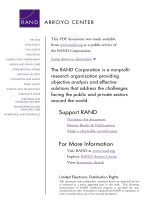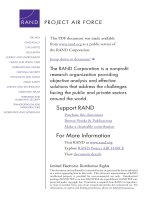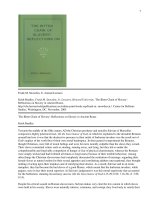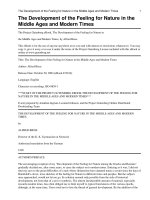The information content of the deflation put options in TIPs
Bạn đang xem bản rút gọn của tài liệu. Xem và tải ngay bản đầy đủ của tài liệu tại đây (901.25 KB, 64 trang )
THE INFORMATION CONTENT OF
THE DEFLATION PUT OPTIONS IN TIPS
LI ZHOU
(B.B.A. (Hons.), NUS)
A THESIS SUBMITTED
FOR THE DEGREE OF MASTER OF
SCIENCE IN MANAGEMENT
DEPARTMENT OF FINANCE,
BUSINESS SCHOOL
NATIONAL UNIVERSITY OF SINGAPORE
2015
1
DECLARATION
I hereby declare that this thesis is my original work and it has been written by
me in its entirety. I have duly acknowledged all the sources of information
which have been used in the thesis.
This thesis has also not been submitted for any degree in any university
previously.
____________________
Li Zhou
2015-1-20
i
Acknowledgements
This thesis could not been written without my supervisor, Associate
Professor Robert Kimmel, who not only gave me guidance and assistance,
but also encouraged me throughout this academic program. He has exhibited a
high degree of commitment and expertise through this thesis development. I
would like to express my sincere gratitude to him for his patience, guidance
and support.
Last but not least, I would like to offer my deepest appreciation to my family
and friends who have given me endless love that enables me to complete this
thesis.
ii
Table of Contents
DECLARATION ........................................................................................................... i
Acknowledgements .......................................................................................................ii
Table of Contents ........................................................................................................ iii
Summary ...................................................................................................................... iv
1
Introduction........................................................................................................... 1
2
The model ............................................................................................................. 8
3
4
5
2.1
Market price of risk..................................................................................... 10
2.2
Decoupling the model ................................................................................. 13
2.3
Pricing TIPS ................................................................................................ 14
2.4
Pricing nominal Treasury bonds ................................................................. 22
Empirical methodology....................................................................................... 24
3.1
The Data ...................................................................................................... 24
3.2
The Kalman filter ........................................................................................ 26
Findings and analysis .......................................................................................... 32
4.1
Estimation results ........................................................................................ 33
4.2
Information content of the embedded deflation option ............................... 36
4.3
Market price of risks ................................................................................... 43
Conclusion .......................................................................................................... 44
References................................................................................................................... 47
Figure I. Estimated Instantaneous Real Interest Rate and Inflation Rate ................... 50
Figure II. Time series of the estimated deflation put option value ............................. 51
Figure III. Time series of the estimated risk premia ................................................... 52
Table I. Parameters Estimation Results ...................................................................... 53
Table II. Summary Statistics ....................................................................................... 54
Table III. Contemporaneous Inflation Regressions .................................................... 55
Table IV. Future Realized Inflation Regressions ........................................................ 56
Table V. Long-term Inflation Forecast Regressions ................................................... 57
Table VI. Commodity market regression.................................................................... 58
Table VII. Equity market regression ........................................................................... 59
iii
Summary
Most prior literature in the research of US Treasury Inflation-Protected
Securities (TIPS) often ignores the embedded deflation put option which
guarantees that bondholders are not adversely affected by deflation. In this
paper, I argue that the deflation put option is non-trivial and there is rich
information content that can be exploited. My estimation shows that the atthe-money 5-year maturity deflation put option has positive and significant
values throughout the sample period over the last 10 years, covering both precrisis economy expansion period and post-crisis recession period. Regressions
analyses reveal the rich information content of the deflation put option. The
option values and returns are significantly correlated with contemporaneous
and future realized inflation up to 4 months ahead, even when other common
inflation expectation measures are included in the regressions. Furthermore,
the option returns are also highly correlated with commodity market returns
and global equity market returns. In this paper, a two-factor term structure
model is constructed and estimated with the Kalman filter and Maximum
Likelihood Estimate method. The parameter estimates are reliable and
significant over the sample period. To account for inflation risk premium and
real interest rate risk premium, I adopt both Dai and Singleton (2000) and
Duffee (2002) market price of risk specifications. The estimates show that the
risk premia for both inflation risk and real interest rate risk are significantly
positive over the sample period with smooth variations.
iv
1 Introduction
In economics, inflation is defined as a sustained increase in the general price
level of goods and services in an economy over a period of time. People care
about inflation. On a micro-level, inflation erodes the purchasing power of
nominal currency. Ultimately, the face value of the nominal currency is just
the medium of exchange; what people can consume is the amount of goods
and services that nominal currency can purchase. On a macro-level, inflation
affects an economy in many ways, both negatively and positively. Negative
effects of inflation include increasing opportunity cost of holding money,
causing people to invest heavily into real-estate, gold and stock markets,
which may potentially create asset price bubble and excess fluctuation. On the
other hand, uncertainty over future inflation would also discourage long-term
investment and saving. But too low the inflation or even deflation is also not
desirable. Japan’s over 20 years’ deflation spiral gives the world a hard lesson
of how painful the deflation environment can be for the economy. The
positive effects of inflation include allowing central banks to adjust real
interest rate to mitigate recessions and encourage investment into real
economy productions and research and development projects. Moderate and
controllable inflation is often desired. Many countries, for example UK,
Canada, Australia, South Korea and Brazil, explicitly adopt inflation targeting
policy as one of their central bank’s macro policy mandate. US, although did
not have an explicit inflation target historically, during the recent financial
crisis, start to set a 2% target inflation rate, bringing the Fed in line with other
countries.
1
The government issued inflation-linked bonds have a relatively short history,
yet this market has grown substantially over the years. As the statistics
compiled by Barclays Capital Research, government-issued inflation-linked
bonds comprise over $1.5 trillion of the international debt market as of 2008.
Countries that issued these instruments include Australia (CAIN series),
Canada (RRB), France (OATi), Israel, Japan (JGBi), Sweden, UK, and US.
US Treasury Inflation Protected Securities (TIPS) market is the largest in the
world. According to the December 2011 report published by the Department
of Treasury, the market capitalization of the TIPS outstanding was about
US$739 billion. The average daily turnover volume exceeded US$8 billion
and new issuance was about US$70 billion each year and growing.
The main focus of this paper is to study the information content of the
deflation put option embedded in TIPS, which is often overlooked in the prior
literature. TIPS are designed to adjust their principal based on an inflation
index, Consumer Price Index for urban consumers (CPI-U). In an inflationary
environment, the principals are upward adjusted such that the purchasing
power of the final payments is protected. However, in a deflation environment,
the final principal will not be adjusted below par. Therefore, precisely
speaking, TIPS are not exactly real interest rate bonds that can be both upward
and downward adjusted with realized inflation, but real rate bonds plus
embedded deflation put options. The options protect investors in a
deflationary environment.
Most prior literature in the research of TIPS often assumes that the value of
this embedded option is trivial. In essence, most researchers implicitly or
2
explicitly assume that the principal payments of TIPS are fully adjusted for
inflation. The argument is that under normal market conditions, moderate
inflation is often expected, and therefore such deflation options would have
little value. Indeed, since 1913 till now, the deflation put option would have
paid off in only one episode – only during the Great Depression. After that for
more than 70 years, US has not experienced long period of deflation.
However, unlike the prior literature, I argue that the deflation put option is
non-trivial and there is rich information content that can be exploited. In this
paper, my estimation shows that the at-the-money 5-year maturity deflation
put option has a positive value at about $0.841 per $100 face value, or about
17 basis points if amortized to yearly basis. The value is statistical significant,
throughout the sample period over the last 10 years, covering both pre-crisis
economy expansion period and post-crisis recession period. There are two
implications of this result. Firstly, the risk of deflation is always priced into
TIPS issuance, even in an inflationary environment. Researchers and industry
professionals therefore need to take special consideration accounting for the
existence of the option in TIPS pricing and evaluation. Secondly, the moneyness of the deflation put option appears to be a confounding factor that
conceals the rich information content in the option. Because of this, prior
literature often fails to detect meaningful estimates of the deflation option
values and subsequently unable to identify the predictability power of the
option for future inflation environment. In this paper, I propose a new time
series: the at-the-money 5-year constant maturity deflation put option. Unlike
the deflation option embedded in a certain TIPS, this option series is
constructed to be always at-the-money and have 5-year maturity. The at-the3
money feature helps to provides clearer channel to test the predictability
power for future inflation by mitigating the money-ness problem of the option
that only captures the historical inflation environment. The 5-year maturity is
chosen to match the 5-year TIPS series and can be easily adjusted in the
pricing formula to other tenures. Besides such flexibility, the constant maturity
feature also provides a constant length of forecasting period ahead, making
time-series wise comparison more objective.
Regressions analyses reveal the rich information content in the time series of
the option values and returns. First of all, the results show that the option
values and returns are highly correlated with contemporaneous inflation
environment. Secondly, the option values and returns have robust and
consistent predictability power for future inflation environment up to 4 months
ahead. These results remain robust even when other factors that are commonly
regarded as measures of inflation expectation, such as yield spreads, gold
returns and TIPS returns, are controlled. Interestingly, neither yield spreads
nor gold returns is able to sensibly predict future inflation environment when
the option present in the regression; TIPS returns appear to have some
predictability power for short-term inflation up to 2 months, but lose the
predictability power going further. Thirdly, the option values and returns are
also correlated with commodity market returns and global equity market
returns. This provides additional evidence supporting inflation/deflation
environment being one of the important factors that have impact on
commodity market and global stock markets. Furthermore, information from
Treasury bonds market, such as TIPS and nominal Treasury bonds, can flow
across to other financial markets.
4
In this paper, I construct a two-factor affine term structure model, in which
bond prices are driven by two state variables, the instantaneous real interest
rate and the instantaneous inflation rate. To solve econometric estimation
problem, I adopt the Kalmen filter and Maximum Likelihood Estimate method.
The parameter estimates are reliable and significant over the sample period.
To account for inflation risk premium and real interest rate premium, I adopt
both Dai and Singleton (2000) and Duffee (2002) market price of risk
specifications. The estimates show that the risk premia for both inflation risk
and real interest risk are significantly positive over the sample period. In
addition, time variations of the risk premia are small. They slightly increase in
the post crisis period and peak in 2012.
This paper studies the very similar topic as Grishchenko, Vanden and Zhang
(2011). It is therefore important to discuss specifically what I follow their
paper and how this paper differentiates from theirs.
To begin with, this paper shares similar modelling specifications as those in
Grishchenko et al. (2011). In their paper, Grishchenko et al. (2011) adopt a
fully flexible formulation of the underlying factors and provide very clear and
thorough derivations in terms of decoupling the system, the various moments
of the factors, and the pricing formula. It is important to point out that such
two-factor affine model is not unique to Grishchenko et al. (2011), but in fact,
a widely used model to describe interest rate term structure in the literature.
The various moments and the bond pricing formula would be found in many
advanced level term-structure textbooks. The ultimate credit I believe should
go to Vasicek (1977) and many other researchers in the field. However, by
5
sharing the same modeling structure as Grishchenko et al. (2011), I benefit
from utilizing their modeling techniques and calculations.
Nevertheless, it is important to point out that my model specification still
differs from Grishchenko et al. (2011) in several ways. Firstly, Grishchenko et
at. (2011) model the dynamics of nominal interest rate and inflation rate, while
mine models real interest rate and inflation rate. The reason to model real
interest rate rather than nominal interest rate is mainly based on empirical
estimation considerations. One of the very important model derivation aspects
relies on the orthogonal property of the two underlying factors. Grishchenko et
at. (2011) adopt linear transformation method. Alternatively, I choose to
model real interest rate. Empirical estimates show severe correlation between
nominal interest rate and inflation rate, but little evidence on real interest rate
and inflation rate. Besides, theoretical arguments, such as Fisher Equation,
link nominal interest rate closely with the inflation rate, while few suggests
the linkage between real interest rate and inflation rate under normal inflation
environment. Secondly, Grishchenko et al. (2011)’s model is under riskneutral probability measure. Instead, I model the underlying dynamics in the
real physical probability measure. This extension gives two advantages. On
one hand, the inflation probability estimated from actual data will be the
actual physical probability measure, which can be directly compared with the
real-life realization. On the other hand, such specification gives the feasibility
to estimate the market price of risk associated with the underlying factors,
which is also an interesting empirical estimates to understand. In short, I adopt
the skeleton of the model specification of Grishchenko et al. (2011), but
6
extend to make further generalizations to account for richer information
estimates.
Furthermore, in the empirical execution part, I took different approach
compared to Grishchenko et al. (2011). Firstly, in their paper, the authors fit
the model to the prices the nominal Treasury bond and TIPS by minimizing
the pricing errors across time series, while in this paper, Kalman filter
technique is utilized to estimate the parameters. The Kalman filter is a linear
estimation method that fits the affine relationship between bond yields and the
state variables. It allows the state variables to be unobserved magnitudes and
utilizes time-series data sequentially to update the parameters. As pointed out
by Duan and Simoato (1999), for a Gaussian affine term structure, the Kalman
filter algorithm provides an optimal solution to predict, updating and
evaluating the likelihood function. Secondly, to account the informational
content of the deflation put options in TIPS, Grishchenko et al. (2011)
construct a deflation option index using the various available options values
estimated from the empirical data. The drawback of this approach is that the
weights assigned to each option value seem arbitrary. It is hard to argue which
option should receive more weights contributing to the index. Furthermore, as
the index is a weighted average reading of the member options, which may
have very different features such as moneyness, time to maturity and so on,
the exact economic meaning of the index is hard to interpret. Worst still, the
index would exhibit substantial variation due to the replacement, as new TIPS
are issued while the old retired. This effect should be eliminated as it is
unrelated to inflation forecasting. As discussed earlier, instead of using the
index, I propose a new time series: the at-the-money 5-year constant maturity
7
deflation put option. Both the moneyness and maturity are controlled in the
series. The economic meaning of the series is clear as the name suggested, and
at the same time mitigates the problems of using index. This approach indeed
gives better result in understanding the information content of the options as
discussed above.
The remainder of our paper is organized as follows. Section 2 introduces the
term structure model and the pricing formula for TIPS and nominal Treasury
bonds. Section 3 discusses the data and empirical methodology for estimating
various parameters. Section 4 presents estimation results and analysis. Section
5 gives concluding remarks.
2 The model
I adopt a two-factor affine term structure model, in which bond prices are
driven by two state variables, the instantaneous real interest rate 𝑤𝑡 and the
instantaneous inflation rate 𝑖𝑡 . The evolution of 𝑤𝑡 and 𝑖𝑡 in continuous time is
described by the following first-order differential equations,
𝑑[
𝑤𝑡
𝑎1
𝐴11
] = ([ ] + [
𝑖𝑡
𝑎2
𝐴21
𝐵11
𝐴12 𝑤𝑡
] [ ]) 𝑑𝑡 + [
𝐵21
𝐴22 𝑖𝑡
𝐵12
𝐵22
]𝑑[
𝑧1𝑡
𝑧2𝑡
]
(1)
where 𝑧1𝑡 and 𝑧2𝑡 are independent Brownian motions under physical
probability measure, ℙ, 𝑎1 , 𝑎2 , 𝐴11 , 𝐴12 , 𝐴21 , 𝐴22 are parameters governing
the drift term, and 𝐵11 , 𝐵12 , 𝐵21 , 𝐵22 are parameters governming the volatility
term. Since this model do not have a unique representation, in other words, an
equivalent model can be constructed by linear transformation of itself, to
ensure the uniqueness of the model, I restrict that 𝐵12 = 0. The appearance of
8
𝐴12 (𝐴21 ) allows spot instantenous inflation rate 𝑖𝑡 (real interest rate 𝑤𝑡 ) to
enter into the drift term of instantenous real interest rate 𝑤𝑡 (inflation rate 𝑖𝑡 ),
yielding a richer set of dynamics between the state variables and better
flexiblity in term structure modeling. Although the direct estimation of this
model looks more complex than the Vasicek (1977) model, using linear
transformation with the eigenvalues and eigenvectors, the model can be
decoupled and estimated in a conventional way. This linear transformation
method was described in details in Grishchenko et al. (2011), therefore here I
only present the transformed result. Readers interested in the linear
transformation method could refer back to Grishchenko et al. (2011) for
details.
This two-factor Vasicek model is commonly used in affine term structure
modelling. The slight generalization instead of the original Vasicek model
specification, with the form of 𝑑𝑟𝑡 = 𝜅(𝜃 − 𝑟𝑡 )𝑑𝑡 + 𝜎𝑑𝑊𝑡 , allows broader
flexibility to account for cases with 𝐴𝑖𝑗 = 0. Furthermore, this model
specification appears similar to that of Grishchenko et al. (2011). However,
there are some differences as follows. Firstly, Grishchenko et at. (2011) model
the dynamics of nominal interest rate and inflation rate, while mine models
real interest rate and inflation rate. The reason to model real interest rate rather
than nominal interest rate is mainly based on empirical estimation
considerations. One of the very important model derivation aspects relies on
the orthogonal property of the two underlying factors. Grishchenko et at.
(2011) adopt linear transformation method. Alternatively, I choose to model
real interest rate. Empirical estimates show severe correlation between
nominal interest rate and inflation rate, but little evidence on real interest rate
9
and inflation rate. Besides, theoretical arguments, such as Fisher Equation,
link nominal interest rate closely with the inflation rate, while few suggests
the linkage between real interest rate and inflation rate under normal inflation
environment. Secondly, Grishchenko et al. (2011)’s model is under riskneutral probability measure. Instead, I model the underlying dynamics in the
real physical probability measure. This extension gives two advantages. First
of all, the inflation probability estimated from actual data will be the actual
physical probability measure, which can be directly compared with the reallife realization. Furthermore, such specification gives the feasibility to
estimate the market price of risk associated with the underlying factors, which
is also an interesting empirical estimates to understand. In short, I adopt the
skeleton of the model specification of Grishchenko et al. (2011), but extend to
make further generalizations to account for richer information estimates.
2.1
Market price of risk
So far the model is built on physical probability measure, but it is often more
convenient to work with risk neutral probability measure in pricing financial
instruments. In the term structure settings, arbitrage-free market assumption
means that bonds of all maturities earn exactly the same risk-adjusted return.
In other words, the market price of risk is independent to the maturity of a
bond. Therefore, the model under physical probability measure can be
transformed into a risk neutral counterpart by incorporating market price of
risk into the drift term. In my model, a generalized dynamics under risk
neutral probability measure ℚ, can be written as
10
𝑤𝑡
𝑑[
𝑖𝑡
ℚ
𝑎1
] = ([
ℚ
ℚ
𝑎2
]+[
𝐴11
ℚ
𝐴12
ℚ
𝐴21
ℚ
𝐴22
𝑤𝑡
ℚ
][
𝑖𝑡
]) 𝑑𝑡 + [
𝐵11
𝐵21
𝐵12
𝐵22
ℚ
]𝑑[
𝑧1𝑡
ℚ
𝑧2𝑡
(2)
]
ℚ
where 𝑧1𝑡 and 𝑧2𝑡 are independent Brownian motions under risk neutral
ℚ
𝑎1
probability, and parameters [
ℚ
𝑎2
] and [
𝐴11
ℚ
𝐴12
ℚ
𝐴22
𝐴21
ℚ
ℚ
] are governing the drift term
under risk neutral probability measure. I adopt both Dai and Singleton (2000)
and Duffee (2002) market price of risk specifications. Both specifications
have their own way to adjust these parameters for risks.
In Dai and Singleton (2000), the market price of risk is modeled as as the
product of instantenous volatility and risk premium compensation for that
volatility. In my model, the market price of risk vector Γ𝑡 is given by
Γ𝑡 = 𝟏 [
𝛾1(1)
𝛾1(2)
]
𝛾1(1)
where [
] denotes risk premium corresponding to each source of risks
𝛾1(2)
[
𝑧1𝑡
𝑧2𝑡
].
The risk adjustment term linking the dynamics in physical probability measure
and risk neutral probability measure is
[
𝐵11
𝐵21
𝐵12 𝛾1(1)
][
] 𝑑𝑡
𝐵22 𝛾1(2)
(3 DS)
Therefore, the risk neutral drift term under Dai and Singleton (2000)
specification is
11
𝑎1
ℚ
[
𝑎1
ℚ
𝑎2
𝐵11
]=[ ]−[
𝑎2
𝐵21
𝐵12
𝐵22
𝛾1(1)
][
𝛾1(2)
]
(4 DS)
ℚ
[
𝐴11
ℚ
𝐴21
𝐴11
=
]
[
ℚ
𝐴22
𝐴21
ℚ
𝐴12
𝐴12
𝐴22
]
This market price of risk specification is of high popularity in term structure
modeling, because of its “completely affine” feature: the dynamics of state
variables under both physical probability measure and risk neutral probability
are affine functions (Duffee 2002). However, as pointed out by Duffee (2002),
this structure imposes two limitations. Firstly, the volatility of state variables
completely determines the variation in market price of risk. This contradicts
with empirical evidence that in fact it is slope parameters, rather than the
volatility parameters, that have significant predictive power for market price
of risk. Secondly, due to the nonnegative feature of the diagonal elements of
volatility matrix, the sign of the elements of market price of risk vector has to
be fixed as same as the sign of the element of the corresponding risk premium.
This feature restricts the ability the model to fit both volatility parameters and
a wide range of term structure shapes.
To fix these two limitations, Duffee (2002) extends Dai and Singleton (2000)
specification by introducing other parameters to change slope coefficients. In
my model, the market price of risk vector Γ𝑡 is given by
Γ𝑡 = 𝟏 [
𝛾1(1)
𝛾1(2)
] + 𝟏[
𝛾2(11)
𝛾2(21)
𝛾2(12) 𝑤𝑡
][ ]
𝛾2(22) 𝑖𝑡
12
𝛾2(11)
where [
𝛾2(21)
𝛾2(12)
𝛾2(22)
] is the set of additional risk premium parameters under
Duffee (2002) specification.
The risk adjustment term linking the dynamics in physical probability measure
and risk neutral probability measure is
[
𝐵11
𝐵21
𝐵12
𝐵22
] ([
𝛾1(1)
𝛾1(2)
]+[
𝛾2(11)
𝛾2(21)
𝛾2(12) 𝑤𝑡
] [ ]) 𝑑𝑡
𝛾2(22) 𝑖𝑡
(3 D)
Therefore, the risk neutral drift term under Duffee (2002) specification is
𝑎1
ℚ
[
𝑎1
ℚ
𝑎2
𝐵11
]=[ ]−[
𝑎2
𝐵21
𝐵12
𝐵22
𝛾1(1)
][
𝛾1(2)
]
(4 D)
[
2.2
𝐴11
ℚ
𝐴12
ℚ
𝐴22
𝐴21
ℚ
ℚ
]=[
𝐴11
𝐴21
𝐴12
𝐴22
]−[
𝐵11
𝐵21
𝐵12
𝐵22
][
𝛾2(11)
𝛾2(12)
𝛾2(21)
𝛾2(22)
]
Decoupling the model
As discussed before, the term structure model right now depicted in Equation
(2) allows spot instantaneous inflation rate (real interest rate) to affect future
instantaneous real interest rate (inflation rate). But the cost of such model
flexibility is calculation complexity. In order to find the closed-form pricing
formula for bonds prices, Grishchenko et al. (2011) provide linear
transformation method to decouple to system. I follow their method and
present the decoupled system as below.
13
𝑑[
𝑌1𝑡
𝑌2𝑡
𝑏1
𝜆1
] = ([ ] + [
𝑏2
0
𝑏1
𝜎12
] [ ]) 𝑑𝑡 + [
𝜎21
𝜆2 𝑌2𝑡
𝜎22
𝑌1𝑡
ℚ
−1
where, 𝑏 = [ ] = Λ
𝑏2
Since the matrix [
𝜎11
0
[
𝑎1
], and Σ = [
ℚ
𝑎2
𝜆1
0
0
𝜆2
𝜎11
𝜎12
𝜎21
𝜎22
] = Λ−1 [
ℚ
]𝑑[
𝑧1𝑡
ℚ
𝑧2𝑡
]
𝐵11
𝐵12
𝐵21
𝐵22
(5)
].
] is diagonal after the transformation, the various
moments of this decoupled Gaussian system can be expressed in the closedform, while the modeling flexiblity to capture the interaction between the
instantenous real interest rate 𝑤𝑡 and instantenous inflation rate 𝑖𝑡 is retained.
The original dynamics of state variables can be easily obtained back from the
𝑤𝑡
𝑌1𝑡
decoupled model. The one-to-one matching relation is [ ] = Λ [ ],
𝑖𝑡
𝑌2𝑡
therefore
𝑤𝑡
ℚ
1
=
[ 𝑖𝑡 ]
2.3
𝐴12
ℚ
[𝜆1 − 𝐴22
1
𝑌1𝑡 + (
ℚ
𝜆2 − 𝐴11
ℚ
𝐴21
ℚ
𝑌1𝑡
=
] [𝑌2𝑡 ]
ℚ
𝐴12
ℚ
𝜆2 − 𝐴11
) 𝑌2𝑡
(6)
𝐴21
(
ℚ ) 𝑌1𝑡 + 𝑌2𝑡
[ 𝜆1 − 𝐴22
]
Pricing TIPS
TIPS are designed to adjust principals based on the realized consumer price
index. But, precisely speaking, TIPS are not exactly real interest rate bonds
because in a deflation environment, the final principal will not be adjusted
below par. Therefore, a zero-coupon TIPS can be decomposed into two parts:
14
a hypothetical zero-coupon option-free real bond (OFRB) which is fully
linked to inflation changes (can be adjusted downward to below the original
par value), and a deflation put option that gives a right for bondholders to
swap the zero-coupon OFRB for a zero-coupon nominal bond in the event of
cumulative deflation. Put into mathematical equation, for a zero-coupon TIPS
that is issued at time 𝑢, matures at time 𝑡𝑛 with principal in nominal dollar $𝐹,
I have:
$𝑃𝑇𝐼𝑃𝑆,𝑡 = $𝑃𝑂𝐹𝑅𝐵,𝑡 + $𝑃𝑝𝑢𝑡,𝑡
where $𝑃𝑇𝐼𝑃𝑆,𝑡 denotes the nominal dollar price of the zero-coupon TIPS
valued at time 𝑡, $𝑃𝑂𝐹𝑅𝐵,𝑡 denotes the nominal dollar price of the hypothetical
zero-coupon OFRB, and $𝑃𝑝𝑢𝑡,𝑡 denotes the nominal dollar value of deflation
put option, whose underlying instrument is the cumulative inflation over the
entire life of the TIPS. Market conventions often quote TIPS prices in the
form of not inflation-adjusted. If one needs to calculate the settlement price,
he/she needs to multiply the market quoted price with the Inflation Index of
that particular TIPS as publicized by US Treasury Department. Nevertheless,
this practice has no impact on the calculation of yield of the particular TIPS.
This is because when calculate the yield, one needs to both adjust the price of
the bond, all remaining coupons and the final principal by the same Inflation
Index. To follow the market convention, all the prices and principals
mentioned throughout the paper are in the form of not-inflation-adjusted,
unless otherwise stated.
To price TIPS, one can evaluate each component respectively. The first
component $𝑃𝑂𝐹𝑅𝐵,𝑡 , the price of the hypothetical zero-coupon OFRB, can be
15
measured in consumption bundles. Its value is fully adjusted for
inflation/deflation: in an inflationary environment, the nominal dollar value of
the OFRB is adjusted higher than the nominal dollar value of par $𝐹, while in
an event of cumulative deflation over the entire life of the TIPS, the nominal
dollar value of the OFRB will be less than the nominal dollar value of par.
To begin with, it is actually easier to see the pricing relation when the inflation
𝑡
adjusted term is included: ($𝐹 ∙ 𝑒 ∫𝑢 𝑖𝑠 𝑑𝑠 ) is the inflation-adjusted final
𝑡
principal in nominal term and ($𝑃𝑂𝐹𝑅𝐵,𝑡 ∙ 𝑒 ∫𝑢 𝑖𝑠 𝑑𝑠 ) is the inflation-adjusted
current price of the TIPS. On the right-hand side, the inflation-adjusted final
principal continues to evolve until the bond matures. Under the model, the
𝑡
𝑡𝑛
final payment is ($𝐹 ∙ 𝑒 ∫𝑢 𝑖𝑠 𝑑𝑠 ) ∙ 𝑒 ∫𝑡
𝑖𝑠 𝑑𝑠
, in nominal term. To measure the
final payment in consumption bundle at the price on the bond issuance date,
we deflate this term by cumulative inflation over the entire life of the bond,
𝑡𝑛
which is 𝑒 ∫𝑢
𝑖𝑠 𝑑𝑠
. This consumption bundle is paid-off far into future, we
𝑡𝑛
therefore discount it back by real-interest rate 𝑒 − ∫𝑡
value of this claim is
𝑡𝑛
ℚ
𝔼𝑡 [𝑒 − ∫𝑡 𝑤𝑠 𝑑𝑠
(
𝑤𝑠 𝑑𝑠
𝑡
𝑡𝑛
($𝐹∙𝑒 ∫𝑢 𝑖𝑠 𝑑𝑠 )∙𝑒 ∫𝑡 𝑖𝑠 𝑑𝑠
𝑡𝑛
𝑒 ∫𝑢 𝑖𝑠 𝑑𝑠
. Finally, the expected
)]. On the left-hand
side, the inflation-adjusted current price is also deflated by cumulative
inflation over the entire life of the bond to obtain the corresponding
consumption bundle at the price on the bond issuance date. In summary, we
have the equation below that prices the hypothetical zero-coupon OFRB in
consumption bundles:
16
𝑡
($𝑃𝑂𝐹𝑅𝐵,𝑡 ∙ 𝑒 ∫𝑢 𝑖𝑠 𝑑𝑠 )
𝑡
𝑒 ∫𝑢 𝑖𝑠 𝑑𝑠
𝑡
=
ℚ
𝔼𝑡 [𝑒
𝑡
− ∫𝑡 𝑛 𝑤𝑠 𝑑𝑠
𝑡𝑛
($𝐹 ∙ 𝑒 ∫𝑢 𝑖𝑠 𝑑𝑠 ) ∙ 𝑒 ∫𝑡
(
𝑡𝑛
𝑒 ∫𝑢 𝑖𝑠 𝑑𝑠
𝑖𝑠 𝑑𝑠
)]
Manipulate the equation and taking out the known parts at time 𝑡, I have
𝑡
𝑡𝑛
ℚ
$𝑃𝑂𝐹𝑅𝐵,𝑡 = $𝐹𝑒 ∫𝑢 𝑖𝑠 𝑑𝑠 𝔼𝑡 [𝑒 − ∫𝑡
𝑤𝑠 𝑑𝑠
]
(7)
𝑡𝑛
− ∫𝑡
The expected value under risk neutral probability measure 𝔼ℚ
𝑡 [𝑒
𝑤𝑠 𝑑𝑠
] can
be expressed in an affine exponential closed form by substituting 𝑤𝑠 with
[𝑌1𝑡 + (
ℚ
𝐴12
ℚ
𝜆2 −𝐴11
) 𝑌2𝑡 ] using the relation with the decoupled model depicted
above in Equation (6). Grishchenko et al. (2011) provided the various
moments for the [
𝑌1𝑡
𝑌2𝑡
] decoupled system, I apply their results in my decouple
model. After grouping, it can be seen that this term is an exponential affine
function:
ℚ
𝔼𝑄𝑡 [𝑒
𝑡
− ∫𝑡 𝑛 𝑤𝑠 𝑑𝑠
ℚ
] = 𝔼𝑡 [𝑒
𝐴12
𝑡
𝑡𝑛
− ∫𝑡 𝑛 𝑌1𝑠 𝑑𝑠−(
ℚ ) ∫ 𝑌2𝑠 𝑑𝑠
𝜆2 −𝐴11 𝑡
] = 𝑒 𝐻(𝑌1𝑡,𝑌2𝑡,𝑡,𝑡𝑛)
where
ℚ
𝑡𝑛
ℚ
𝐻(𝑌1𝑡 , 𝑌2𝑡 , 𝑡, 𝑡𝑛 ) = −𝔼𝑡 [∫ 𝑌1𝑠 𝑑𝑠] − (
𝑡
ℚ
𝑡𝑛
𝑡𝑛
1
ℚ
ℚ
)
𝔼
[∫
𝑌
𝑑𝑠
]
+
𝑉𝑎𝑟
[∫
𝑌1𝑠 𝑑𝑠]
2𝑠
𝑡
𝑡
ℚ
2
𝜆2 − 𝐴11
𝑡
𝑡
𝐴12
2
𝑡𝑛
1
𝐴12
ℚ
+ (
)
𝑉𝑎𝑟
[∫
𝑌2𝑠 𝑑𝑠]
𝑡
ℚ
2 𝜆2 − 𝐴11
𝑡
ℚ
+(
𝐴12
𝜆2 −
ℚ
ℚ ) 𝐶𝑜𝑣𝑡 [∫
𝐴11
𝑡
𝑡𝑛
𝑡𝑛
𝑌1𝑠 𝑑𝑠 , ∫ 𝑌2𝑠 𝑑𝑠]
𝑡
17
I can group the expression, such that
𝐻(𝑌1𝑡 , 𝑌2𝑡 , 𝑡, 𝑡𝑛 ) = 𝐽(Ψ, 𝜏) + 𝐾(Ψ, 𝜏) [
𝑌1𝑡
𝑌2𝑡
]
where Ψ denotes vector of parameters in the model and 𝜏 denotes the length of
time between the valuation time 𝑡 to maturity time 𝑡𝑛 ; 𝐽(Ψ, 𝜏) is the intercept
and 𝐾(Ψ, 𝜏) is the coefficient in front of [
𝑌1𝑡
𝑌2𝑡
].
The continuously compounding yield of the hypothetical zero-coupon OFRB,
denoted as 𝑅𝑂𝐹𝑅𝐵,𝑡 , can be obtained from the pricing formula. Therefore,
𝑌1𝑡
1 $𝑃𝑂𝐹𝑅𝐵,𝑡
1
1
𝑅𝑂𝐹𝑅𝐵,𝑡 = − ln
= − 𝐽(Ψ, τ) − 𝐾(Ψ, τ) [ ]
𝑡
𝜏 $𝐹𝑒 ∫𝑢 𝑖𝑠 𝑑𝑠
𝜏
𝜏
𝑌2𝑡
(8)
To price the second component $𝑃𝑝𝑢𝑡,𝑡 , the value of deflation put option, I
first look at how the option pays-off at maturity. The underlying instrument of
the option is cumulative inflation over the entire life of TIPS, which is
calculated as the ratio of the reference CPI-U on the valuation date to that on
𝑡𝑛
the issuance date of the TIPS. In my model, this is denoted by 𝑒 ∫𝑢
𝑖𝑠 𝑑𝑠
, which
is larger than 1 when cumulative inflation occurs over the life and the option
will be worthless; and less than 1 when cumulative deflation occurs and the
put option will be exercised to swap the downward adjusted the hypothetical
zero-coupon OFRB with nominal dollar $𝐹. The payoff function at maturity,
measured by nominal dollar, is
18
𝑡𝑛
$𝑃𝑝𝑢𝑡,𝑡𝑛 = max (0, $𝐹 − $𝐹𝑒 ∫𝑢
𝑖𝑠 𝑑𝑠
)
The option value at time 𝑡 can be calculated by discounting the payoff at
maturity back to time 𝑡, measured in consumption bundles
$𝑃𝑝𝑢𝑡,𝑡
𝑒
𝑡
∫𝑢 𝑖𝑠 𝑑𝑠
𝑡𝑛
=
ℚ
𝔼𝑡 [𝑒
𝑡
− ∫𝑡 𝑛 𝑤𝑠 𝑑𝑠
(
max (0, $𝐹 − $𝐹𝑒 ∫𝑢
𝑒
𝑖𝑠 𝑑𝑠
𝑡
∫𝑢𝑛 𝑖𝑠 𝑑𝑠
)
)]
Manipulating the equation and taking out the known parts at time 𝑡, I have
𝑡𝑛
ℚ
$𝑃𝑝𝑢𝑡,𝑡 = $𝐹𝔼𝑡 [𝑒 − ∫𝑡
𝑤𝑠 𝑑𝑠
𝑡
𝑡𝑛
(𝑒 − ∫𝑢 𝑖𝑠 𝑑𝑠 − 𝑒 ∫𝑡
𝑖𝑠 𝑑𝑠
) 1{− ∫𝑡 𝑖
𝑡𝑛
𝑢 𝑠 𝑑𝑠>∫𝑡 𝑖𝑠 𝑑𝑠}
]
(9)
where 1{… } is the indicator function for the event of cumulative deflation.
To evaluate equation (9), Grishchenko et al. (2011) provide close form
𝑍1
solutions. For equation with the form 𝔼ℚ
𝑡 [𝑒 1{𝑑>𝑍2 } ], where 𝑍1 and 𝑍2 are
bivariate normally distributed random variables and 𝑑 is a constant. The value
of this form is solvable in a closed form
ℚ
𝔼𝑡 [𝑒 𝑍1 1{𝑑>𝑍2 } ]
=
ℚ
ℚ
𝑑 − 𝔼𝑡 (𝑍2 ) − 𝐶𝑜𝑣𝑡 (𝑍1 , 𝑍2 )
1
ℚ
ℚ
(𝑍 )+
(𝑍 )
𝑒 𝔼𝑡 1 2𝑉𝑎𝑟𝑡 1 𝑁
(
√𝑉𝑎𝑟𝑡ℚ (𝑍2 )
)
where 𝑁(∙) is the standard normal cumulative distribution function. I follow
the calculations in Grishchenko et al. (2011) to find out the various moments
for the expression.
Recent literature starts to recognize the unique information content in the
option value calculated above as it reflects the (expected) cumulative
19
inflation/deflation environment over the entire life of a particular TIPS.
Grishchenko et al. (2011) for example use the estimated option values to
construct an deflation option index and show such index are highly correlated
with concurrent and future inflation environment. Christensen, Lopez and
Rudebusch (2011) and Li (2012) show that the value of 𝑁(∙), so-called risk
neutral deflation probability, provides a risk neutral probability measure on
the market consensus on the likelihood that the TIPS would mature with zero
or negative cumulative inflation.
Some attempts have been made by researchers to understand the information
content of the deflation put options. Grishchenko et al. (2011) construct a
deflation option index using the various available options values estimated
from the empirical data. However, there are several drawbacks of this
approach. To begin with, the weights assigned to each option value seem
arbitrary. It is hard to argue which option should receive more weights
contributing to the index. Secondly, as the index is a weighted average reading
of the member options, which may have very different features such as
moneyness, time to maturity and so on, the exact economic meaning of the
index is hard to interpret. Thirdly, the index would exhibit substantial
variation due to the replacement, as new TIPS are issued while the old retired.
This effect should be eliminated as it is unrelated to inflation forecasting.
Moreover, in this paper, I argue that the option value directly estimated from a
TIPS is confounded by the money-ness of the option. To obtain clearer
information content of the deflation option, one should remove the moneyness before further analysis. Usually, the option value is determined by two
20
